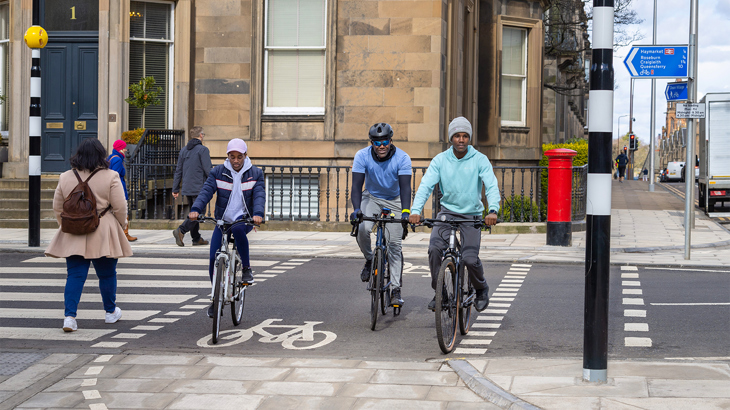We believe that everyone should be able to experience the benefits of active travel. A new report by Sustrans summarises the evidence around neurodivergent people’s experiences of walking, wheeling and cycling in Scotland.

Community mural at Coalie Park on the Water of Leith. Credit: Michael Kelly/Sustrans
What is neurodivergence?
Neurodivergence refers to ways of processing, learning and behaving which differ from what is considered ‘normal’ or ‘neurotypical’.
Neurodivergent people may therefore communicate, socialise, move, sense and interpret things differently to the wider population.
Neurodivergence is used to describe a range of neurological differences including autism, ADHD and dyslexia.
It is estimated that up to 15% of people in Scotland are neurodivergent. [1]
What did we do?
For this research, funded by Transport Scotland through the Scottish Research Programme, we conducted a thorough review of existing literature on neurodivergence and active travel.
We identified how neurodivergence affects people’s travel choices and experiences.
This included identifying barriers and enablers of active travel for neurodivergent people and making recommendations to address these barriers.

For people with hypersensitivity to noise, smells and light, busy streets can be overwhelming and anxiety-inducing. Credit: Alan McAteer/Sustrans
Barriers to active travel
The review found that neurodiversity impacts all elements of active travel, from travel choices to experiences of the journey.
Existing research identified the following common impacts experienced by neurodivergent people:
- Travel is often an overwhelming and tiring experience: Neurodivergent people may experience difficulties with journey planning and navigation because of inconsistent street design, unclear signage and unexpected changes.
- Public space and travel environments are often inaccessible: For people with hypersensitivity to noise, smells and light, busy streets and paths can be overwhelming and anxiety-inducing. Some neurodivergent conditions also impact balance and spatial awareness, making physically inaccessible environments more hazardous to navigate.
- Traffic-related safety concerns: Although fear of traffic is common among all active travel users, neurodivergent people may be more at risk of collisions with other road users because of issues with spatial awareness and executive functions such as information processing and decision making.
- Personal safety concerns: Neurodivergent people may feel less safe within their local communities because of fears around harassment. Other aspects of people’s identities, such as gender, sexuality or ethnicity, can intersect with neurodivergence to increase the risk of street harassment.
- Transport poverty: Neurodivergent people are disproportionately likely to live in poverty because of the costs associated with disability and barriers to employment.
- Exclusion from decision-making: Transport systems are typically planned by and for neurotypical people. Neurodivergent people may face barriers to employment in decision-making positions, and community engagement processes may be inaccessible. This means the needs of neurodivergent people are often overlooked.
These challenges restrict travel choices and lead many neurodivergent people to limit the amount they travel.
This restricts neurodivergent people’s access to opportunities, places, people and services.

Separating transport modes, introducing frequent crossings and improving signage can all help neurodivergent people travel more safely. Credit: Colin Hattersley/Sustrans
Recommendations
We identified the following recommendations to address the barriers identified across six key areas:
- Provide a choice of sensory environments in public space
- Ensure the travel environment is as physically accessible as possible
- Segregate transport modes to provide more space for walking and wheeling
- Make travel environments simple and consistent, and make journey planning information easy to access and understand
- Introduce more funding for neurodivergent people’s transport and expand existing schemes (e.g. Disabled Person’s Railcard) to cover neurodivergence
- Include neurodivergent people in decision-making
Looking forward
Current active travel policies in Scotland and the UK do not directly address the link with neurodivergence.
We hope this evidence review will shape future active travel policy and infrastructure design to be more inclusive.
This is a new area of research with very limited evidence focusing specifically on the experiences of neurodivergent people relating to active travel.
Much of the research we reviewed looked at disability more broadly.
This presents opportunities for future research.
We are currently conducting research based on interviews with neurodivergent people in Scotland about their experiences of active travel, which we hope will begin to address this evidence gap.
Read the full report here.
1 (2023) Learning Disabilities, Autism and Neurodivergence Bill: consultation, Scottish Government, available online.






